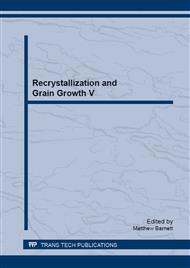p.423
p.427
p.431
p.435
p.439
p.443
p.449
p.453
p.459
Influence of Finishing Rolling Variables on the Austenite Recrystallization and Grain Growth
Abstract:
The austenite recrystallization and grain growth during thermo-mechanical control processing (TMCP) of a pipeline steel grade is described and analysed in terms of precipitation state progress. The influences of finish rolling temperature and cooling rate on the link between microstructure-precipitation evolution and their consequent effect on the mechanical properties were examined. Two stage controlled rolling (roughing and finishing) was carried out on a laboratory rolling mill for a set of completed and interrupted schedules. Subsequent to rolling, two different cooling routes were used (air-cooling and accelerated water cooling (ACC) together with coiling simulation). From the combination of transmission electron microscopy (TEM) observations, detailed texture analysis and inductively coupled plasma-mass spectroscopy (ICPMS) precipitates quantification, consistent correlations between precipitation state and microstructure at every stage of TMCP can be recognized. The role of grain size and precipitation on final mechanical properties was discussed based on different strengthening mechanisms.
Info:
Periodical:
Pages:
439-442
Citation:
Online since:
March 2013
Price:
Сopyright:
© 2013 Trans Tech Publications Ltd. All Rights Reserved
Share:
Citation:


